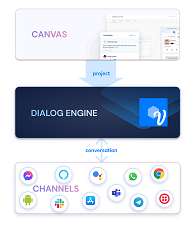Voiceflow Extends Beyond Alexa and Google Assistant with New Solutions to Design, Prototype and Launch Voice Experiences Across Conversational Channels
 Voiceflow introduced a comprehensive upgrade for its voice app design and prototyping platform at an online event Monday called Voiceflow V2. The overhaul took about a year but puts all of the design, prototype, and development elements of conversational design within the platform while making the result usable on a wide range of channels
Voiceflow introduced a comprehensive upgrade for its voice app design and prototyping platform at an online event Monday called Voiceflow V2. The overhaul took about a year but puts all of the design, prototype, and development elements of conversational design within the platform while making the result usable on a wide range of channels
Design and Prototype Voiceflow V2
Since it launched in 2018, Voiceflow has grown to host more than 200 million interactions a year through more than 7,000 voice apps. Voiceflow V2 is clearly aimed to break those records with changes and improvements to pretty much every facet of the platform. The result is a way to design and test a voice app for any channel, like a self-contained voice assistant for the developers that can shape itself to work with far more platforms than just Amazon Alexa or Google Assistant. Designers can consolidate all of their documents and information in a single place, and real-time collaboration among the team working on a project can be done using a canvas markup to make the documentation easier to read and adjust. The projects are exportable not only as a .VF file, but in a format suitable for DialogFlow, Microsoft Luis, or IBM Watson.
“Conversation design requires high fidelity capability, context modeling, dialog management, but also being able to manage the readability and documentation standards of the design,” Voiceflow CEO Braden Reamn said during the presentation. “We’re trying to find that balance at Voiceflow so that you can have highly contextual engaging conversation designs that are also very sharable and very readable.”
After designing the voice app, Voiceflow offers a lot of new prototyping tools that can enhance and shorten the time it takes to get the project ready to publish. Rapid prototyping that tests the voice app with the push of a button, live prototyping to share the work in progress with others to see what they think, and more advanced demos to run by stakeholders are all now options for Voiceflow users.
“Prototyping is a catalyst for great conversation design,” Voiceflow explained in announcing the updated platform. “As designers continue to push the boundaries for voice and conversation design, they need tools that can represent their end-user experience at parity with the platforms they’re building for.”
Channeling the Voiceflow
“There’s always been one feature, and especially last year that we continue to hear [about] from customers. When can I use Voiceflow for channels outside of Amazon Alexa and Google Assistant,” Ream said. “We’ve actually been thinking about this for a long time and it’s actually always been our plan for Voiceflow your single source of truth for all your conversational channels.”
 Voiceflow’s intent with the new version of its platform to deploy the voice apps after they’ve been designed and prototyped to deploy on other platforms. There are quite a few where apps built on Voiceflow can now operate. Multiple SDKs can be generated by Voiceflow’s open-source engine. You can see a range of examples in the image to the right. Facebook Messenger, Slack, Twilio, and WhatsApp are among the many platforms represented as options for the products put together on Voiceflow.
Voiceflow’s intent with the new version of its platform to deploy the voice apps after they’ve been designed and prototyped to deploy on other platforms. There are quite a few where apps built on Voiceflow can now operate. Multiple SDKs can be generated by Voiceflow’s open-source engine. You can see a range of examples in the image to the right. Facebook Messenger, Slack, Twilio, and WhatsApp are among the many platforms represented as options for the products put together on Voiceflow.
“At a high level, Voiceflow V2 adds new professional design and prototyping features while also extending its capabilities to launch and work with any conversational channel,” Ream said. “Our goal at Voiceflow is to be your company’s central hub for your conversational designs across all channels in the same way you have a central hub for your visual designs like Figma and Adobe XD.”
Follow @voicebotai Follow @erichschwartz
Voiceflow Launches Real-time Collaboration and Reduces Cost for Independent Voice App Developers








